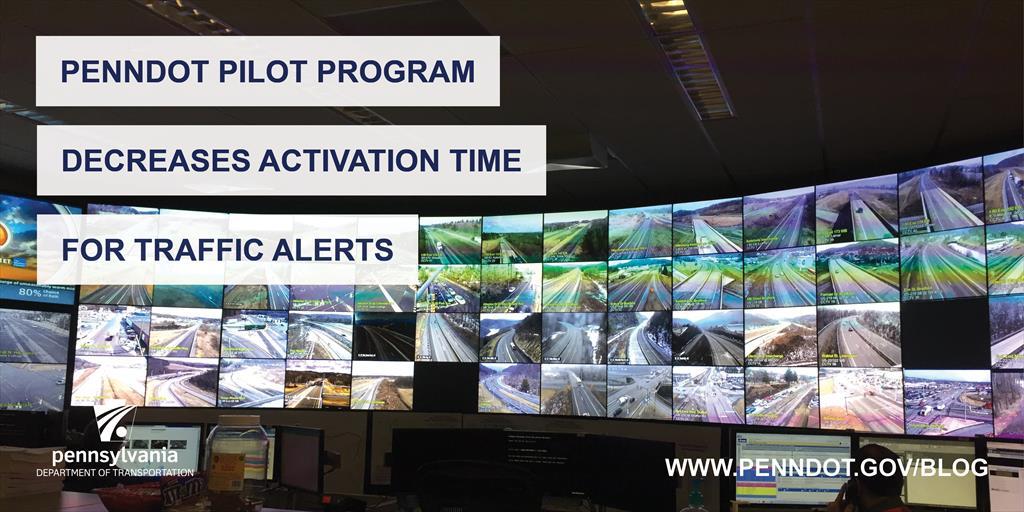
With operations becoming a vital function of PennDOT, staff has been reviewing how to use smart practices to make ourselves more efficient. The Central Regional Traffic Management Center (RTMC), which is housed in the District 2 office in Clearfield, has been piloting a partnership with Clearfield County 911.
The "status display" — or "Web CAD" — pilot program integrates County 911's computer-aided dispatch console directly into the Regional Traffic Management Center's standard operating procedure and operations. The integration of status display has resulted in decreased response times, reduction of phone calls to emergency stakeholders, and an increase in RTMC efficiency.
The goal of this pilot project was to reduce the incident influence timeline between when the incident occurs and when intelligent transportation system (ITS) devices — like dynamic messages signs, highway advisory radio, and road condition reporting system — are activated. Since its induction, the program has decreased activation times by more than 20 minutes. The RTMC now has the capability to activate ITS devices within the first 10 minutes of an incident, which then increases the safety for emergency responders and the traveling public.
The Clearfield 911 Center also is seeing benefits. Those include cost savings for obtaining the closed-circuit video feeds, the ability to create a video display wall of their own, and lessening the phone call burden on 911 operators by reducing the need to make back-and-forth calls between agencies.
With the success of this pilot project, the Central RTMC has been meeting with other county 911 centers and county commissioner boards to discuss the safety and cost-saving benefits that can be realized through a PennDOT/911 partnership.
Because of these meetings, the Centre County 911 Center has agreed to provide its live 911 Web CAD feed to hopefully reduce the volume of phone calls necessary when an incident occurs. Within the coming months, the Central RTMC hopes to expand to Clinton and other counties within the region.

ABOUT THIS BLOG
Did you know PennDOT is directly responsible for nearly 40,000 miles of highway and roughly 25,000 bridges? We oversee programs and policies affecting highways, urban and rural public transportation, airports, railroads, ports and waterways, in addition to administering the state's more than 11 million vehicle registrations and 8.8 million driver's licenses.
So, how do we do what we do? And how can we help you travel in Pennsylvania — whether it be for business or leisure — in safe and enjoyable manner? Read PennDOT Way to learn more about the department, what we do, and how and why we do it.
TAGS
50-Year Anniversary, 511PA, Aggressive Driving, Airports, Autonomous Vehicles, Bicycles, Bridges, Child Safety, Community Relations, Construction, COVID-19, Distracted Driving, District 1, District 10, District 11, District 12, District 2, District 3, District 4, District 5, District 6, District 8, District 9, DOTcom, Driver and Vehicle Services, Emergency Responders, Employment, Equity, FAQ Friday, Human Trafficking, Impaired Driving, Innovations, Live Free Ride Alive, Maintenance Monday, Motorcycles, Older Drivers, PA Motorcycle Safety Program, Pedestrians, PennDOT Connects, Ports, Public Transit, Railroads, REAL ID, Road MaP, Roadside Beautification, Rural Roads, Safety, School Buses, Seat Belts, State Transportation Innovation Council (STIC), Sustainability, Teen Drivers, Throwback Thursday, Transportation Funding, Travel in PA, Welcome Centers, Winter, Work Smart, Work Zone, Yellow Dot
LATEST POSTS
PennDOT Continues Sharing, Updating Resources for Local Governments to Pursue Bipartisan Infrastructure Law Funding Opportunities
Norwin High School Wins 2024 ‘Innovations Challenge’
Demo Complete: I-95 CAP Project in Center City Philadelphia
PennDOT Archeologist Connects Past, Present, and Future
Lehigh Valley DUI, Highway Safety Task Force Hosts Law Enforcement Seminar
ARCHIVES
2024
2023
2022
2021
2020
2019
2018
2017

